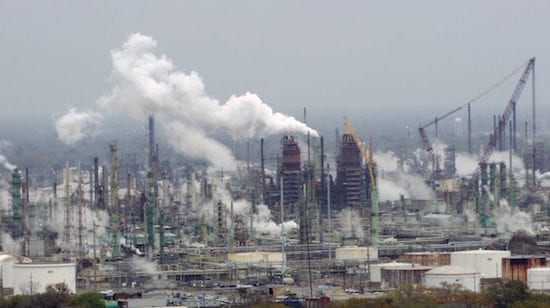Heading into their annual meetings at the end of this month, both ExxonMobil and Chevron have published reports in response to investor demands that they disclose their plans for a world in which global temperature increase is kept well below two degrees Celsius (2°C) above pre-industrial levels—the target set in the Paris Climate Agreement.
Mounting mainstream expectations for better corporate climate risk disclosure have been reflected in shareholder resolutions and the recommendations of the Task Force on Climate-Related Financial Disclosure (TCFD).
Should ExxonMobil and Chevron shareholders be satisfied with these reports? No—and there are indications that some are not. I took a look at these reports, consulted with other UCS experts, and identified four big questions left unanswered.
1) When will they get serious about the Paris Climate Agreement temperature targets?
Both ExxonMobil and Chevron seem to bet against the world achieving the Paris Climate Agreement goal of keeping global temperature increase well below 2°C over pre-industrial times—and striving to limit warming to 1.5°C.
A former ExxonMobil executive recently criticized the reports for “assum[ing] that governments won’t succeed in meeting their Paris Agreement commitments, resulting in financial outlooks that leave them free to sell all their fossil fuel assets.”
ExxonMobil admits that the emissions trajectory of its Outlook for Energy (which does not extend to 2100) “closely approximates in shape” an emissions profile of the Intergovernmental Panel on Climate Change (IPCC) that “would result in an average global temperature increase of approximately 2.4 °C by 2100 from the industrial age.”
ExxonMobil’s “2018 Energy and Carbon Summary: Positioning for a Lower-Carbon Energy Future” presents a false choice between curbing climate change and solving other pressing problems, warning that “Inefficient approaches to address the risks of climate change can divert resources and detract from society’s ability to address other important priorities” such as poverty, education, health, and security.
Like ExxonMobil, Chevron also emphasizes potential conflicts rather than synergies between climate solutions and other societal goals: “As we work to address climate change, we must create solutions that balance environmental objectives with global economic growth and our aspirations for a better quality of life for people across the world.”
Under new CEO Michael Wirth, Chevron seems to be sticking with the same old business plan. Its report, “Climate Change Resilience – A Framework for Decision Making,” states that “Chevron’s views on the future energy mix are generally aligned with prominent third-party projections like the IEA’s [International Energy Agency’s] NPS [New Policies Scenario].”
The NPS takes into account Nationally Determined Contributions (NDCs) under the Paris Agreement—with modifications such as the announced U.S. withdrawal—commitments that are acknowledged to fall far short of what is needed to meet the agreement’s global temperature goals.
Does Chevron urge greater ambition to keep global warming well below 2°C and transform our energy system? Um, no. Far from it. Instead, the company dismisses the notion of a peak in oil demand as unlikely on the basis that “a series of critical demand-reducing factors would need to occur simultaneously, apply across the entire slate of oil products and move at an unprecedented pace.
Such a confluence of events in the next two decades would represent a historic and unprecedented revolution.” Wasn’t the Paris Agreement intended to spark just such a revolution?
2) Why do they bank on burning like there’s no tomorrow?
If fossil fuel companies support achieving net-zero carbon emissions by shortly after mid-century, they should commit to reaching net-zero with their own emissions, right?
Wrong. Neither ExxonMobil nor Chevron seems to envision much disruption to the business of extracting, refining, and marketing fossil fuels.
In response to a 2018 shareholder proposal, Chevron goes so far as to “… disagree with the premise… that future diversification of energy sources requires all energy producers to curtail production of fossil fuel resources and/or to diversify their portfolios proportionately.
A decrease in overall fossil fuel emissions is not inconsistent with continued or increased fossil fuel production by the most efficient producers.
We believe Chevron is a capable and efficient energy producer, well positioned to participate in meeting future energy demand regardless of other energy sources that may become competitive.” (Unfortunately for Chevron, its competitors seem to have a similar “Survivor: Fossil Fuel Industry” mentality about 2°C scenario planning.)
Meanwhile, ExxonMobil anticipates that over 90 percent of its year-end 2016 proved reserves will have been produced by 2040, and believes “these reserves face little risk.” The company expects to sink substantial cash into developing the remaining 10 percent over the next couple of decades, such that “the production of these reserves will likely remain economic” even under a 2°C scenario.
Still, both ExxonMobil and Chevron admit that some of their assets may not be profitable to develop in a world where temperature increase is kept well below 2°C:
- ExxonMobil allows that “some higher-cost assets, which could be impacted by many factors including future climate policy, may not be developed,” but estimates that these assets account for less than 5 percent of the company’s total property value.
- In a sidebar headlined “The ‘stranded assets’ theory,” Chevron acknowledges the possibility that not all oil and gas assets will get produced. In a discussion of stress-testing its portfolio against the IEA’s Sustainable Development Scenario, Chevron tacitly admits that several of its projects may not be profitable in a low-price environment, noting that they will generate cash but not necessarily earnings.
3) How about transparency we can use?
Both ExxonMobil and Chevron talk a good game about transparency in these reports. ExxonMobil shares more information about its energy forecasts; Chevron focuses more on strategy and includes some asset-level disclosure.
However, it is difficult to extract and compare the assumptions underlying both reports. For example, although ExxonMobil and Chevron are both defendants in lawsuits by a dozen communities seeking to hold them accountable for climate damages and adaptation, ExxonMobil’s report fails to acknowledge the rise of climate liability litigation as a potential risk to its business. (Chevron acknowledges the lawsuits but dismisses them as “factually and legally without merit”).
Greater transparency on metrics such as emissions along the supply chain, internal use of carbon prices, and investments in low-carbon technology research and development is necessary in order to make meaningful comparisons among different fossil fuel companies’ 2°C scenario plans, and to assess each company’s progress toward its stated commitments.
(Read my colleague Jeremy Martin’s blog about why improved transparency along the oil and gas supply chain matters).
As issuing 2°C reports becomes the norm for companies across the oil and gas sector, investors must demand comprehensive, consistent, and comparable disclosures. Standard-setters like Task Force on Climate-Related Financial Disclosures (TCFD), CDP (formerly Carbon Disclosure Project), and the Sustainability Accounting Standards Board (SASB) have a role to play—and so do regulators like the Securities and Exchange Commission (SEC).
4) What’s behind the PR Fanfare about Low-Carbon Investments?
Both ExxonMobil and Chevron fail to set targets for reducing heat-trapping emissions—a glaring omission in any fossil fuel company’s consideration of its plans for a low-carbon world. They also fail to identify opportunities to play a leading part in the clean energy economy.
Chevron emphasizes “flexible investment strategies” and claims that “setting targets, such as investing a predetermined percentage of renewables within our asset base, could limit our ability to select the most profitable energy development opportunities.”
ExxonMobil is laughably lacking in ambition with regard to renewables, highlighting its role as a supplier of lubricants for wind turbines. As my colleague John Rogers (no stranger to wind turbines) observed,
While lubrication is important, in the context of ExxonMobil’s anti-climate activities, this seems akin to taking credit for a skyscraper project because you supplied the signs for the restroom doors… while simultaneously taking a jackhammer to the building’s foundations under cover of night.
Both companies tout their investments in low-carbon research and development—sums that are a pittance in comparison with their spending on oil and gas exploration and infrastructure. For example (thanks to my colleague Nicole Pinko for number-crunching):
- ExxonMobil reports spending more than $8 billion since 2000 to develop and deploy higher-efficiency and lower-emission energy solutions across its operations—less than 2 percent of its capital and exploration expenditures during the same timeframe.
- Chevron says it has invested more than $75 million in carbon capture and storage (CCS) research and development over the past decade—well under 1 percent of its capital and exploration spending during that time. The company also reports $1.1 billion of investment in two projects—Quest in Canada and Gorgon in Australia—that include CCS. Impressive? Not compared with Chevron’s $20+ billion annually in capital and exploration spending over the past couple of decades.
ExxonMobil’s and Chevron’s climate risk reports illuminate the far-reaching risks of these companies’ reliance on ever-increasing sales of fossil fuel products. Now is the time for consumers, investors, public prosecutors, policy makers, and others to demand answers to the above questions, and insist that major fossil energy producers use their enormous resources and technical capacity to make real plans for a 2°C world.
UCS will be at the ExxonMobil and Chevron annual meetings at the end of May, highlighting these gaps and following up on these outstanding questions. Look for upcoming blogs delving further into major fossil fuel companies’ reporting and disclosures, incorporating insights from several of my UCS colleagues.
Source: UCSUSA. Reproduced with permission.







